Steps To Keep The Flowers Alive All Season
Your hanging flower baskets can become pieces of floral artwork. You can design them with color and form to enhance whatever place in your garden or patio needs some height and interest. They always create a surprise for you and guests. You can even add flowers for scent or to trail downward.
Once you have done the design work and planting you will want to ensure that they last for your full growing season. Here is how!
Four Steps For Hanging Baskets That Last All Season!
It is hard to resist these balls of floral color hanging at eye level. They attract us as any flowers do, but they are not where we expect them. Is that why people love them so much? The hanging flowers are a surprise! They brighten our streets, perk up the entryway and make the porch a porch
There is no more ubiquitous Mother’s Day gift than a hanging ball of floral color, and I write this to help you make the gift last.
Keeping Them Blooming And Beautiful Everywhere
Hanging floral baskets say welcome in tiny towns and big cities everywhere. The presence of these flowers in containers tells us that somebody loves this place, they are welcoming, and they say we care. I think that some marketing genius somewhere knows that I’ll pay more for nice shoes in a shop with flower baskets than in a big mall.
“Ride A Cock Horse To Banbury Cross”
The first image of this article was taken in Banbury in Oxfordshire in the UK. It’s a famous nursery rhyme; someone probably read it to you when you were a baby. This ancient medieval market town is still welcoming people the same way it always did, and it does love its flower baskets. Not only did we see the hanging baskets in the photos and all over town, they even make tree-shaped frames of flower baskets in the medians of the city streets. I guess that’s civic pride.
How To Make The Planters
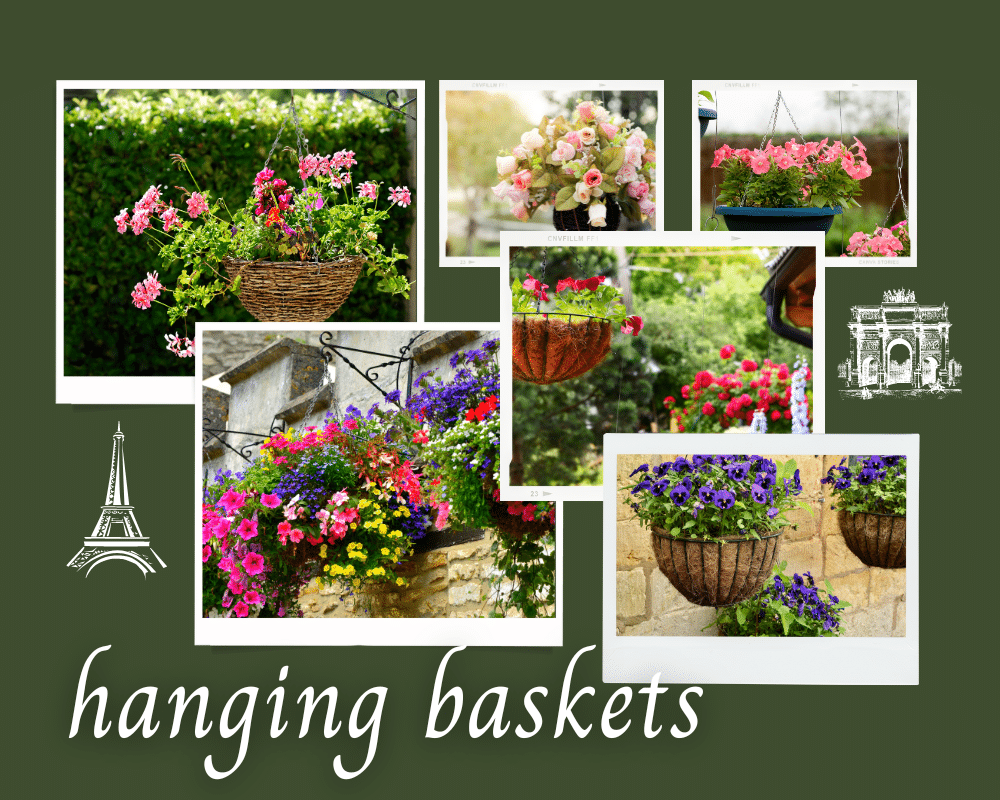
This is a simple project, pretty flowers in a container hanging where you want them. The key fact to remember is that this is not a normal garden. These flowers are leading an artificial life for our pleasure. The available amount of soil is small; they require regular water as they are dried by the breeze, and we feed them more because the regular watering will leach the nutrition from the soil.
There are no esoteric skills required, and the workload is light. Persistence is the virtue that will bring you success with hanging baskets. These are tiny but significant mini gardens and are well worth the attention.
Four Steps To Follow
There are four steps to making and keeping these planters at their most enjoyable. They are:
- The Right Planter-size, shape, material
- The Right Plants-sun/shade, habit
- Best Method-soil, fertilizer, planting
- Best Maintenance-water, nutrition
I just finished a set of four baskets that frame the view from the kitchen, dining patio, and pool.
They hang on hooks slightly shaded by three Queen Palm trees. They frame the pond view beyond the lawn. The plantings below we have always enjoyed, but it’s the baskets that raise your eye up to the view beyond. The border planting beds can’t do that.
This will give us months of pleasure, and we can get another season with just a few changes.
1. The Right Planter-Choices to Last All Season
There are two basic choices in the planters, followed by a few features you will want to know about. Plants in hanging baskets live in tight quarters; nutrition and water are important.
Basket Materials
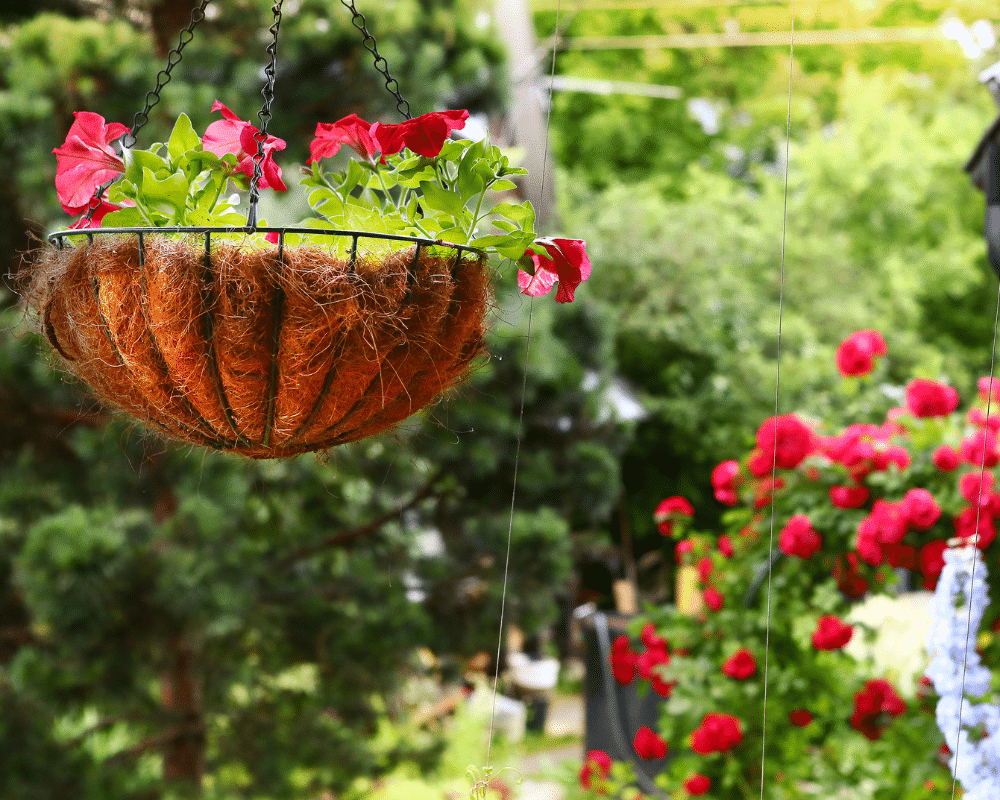
Coir Baskets: Reasonably light in weight (we will be lifting these up), natural, porous, and biodegradable. You keep the metal frames and chain and replace the coir (made from the outer husk of coconuts) linings as needed. The appearance is very natural in a garden.
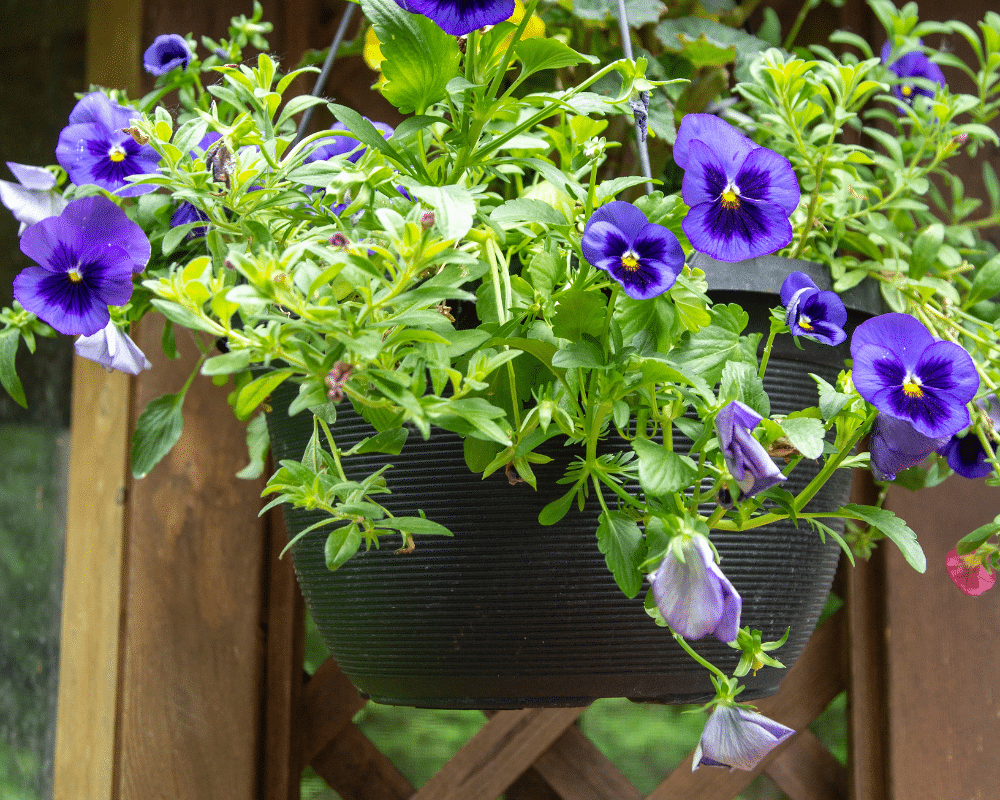
Plastic: Also light in weight, they have the advantage of holding water for a little longer; you might appreciate this in a dry summer. They do have drainage holes; drainage is imperative. Their appearance is artificial – but if you include full trailing plants, such as petunias, the pot will be covered.
Basket Sizes
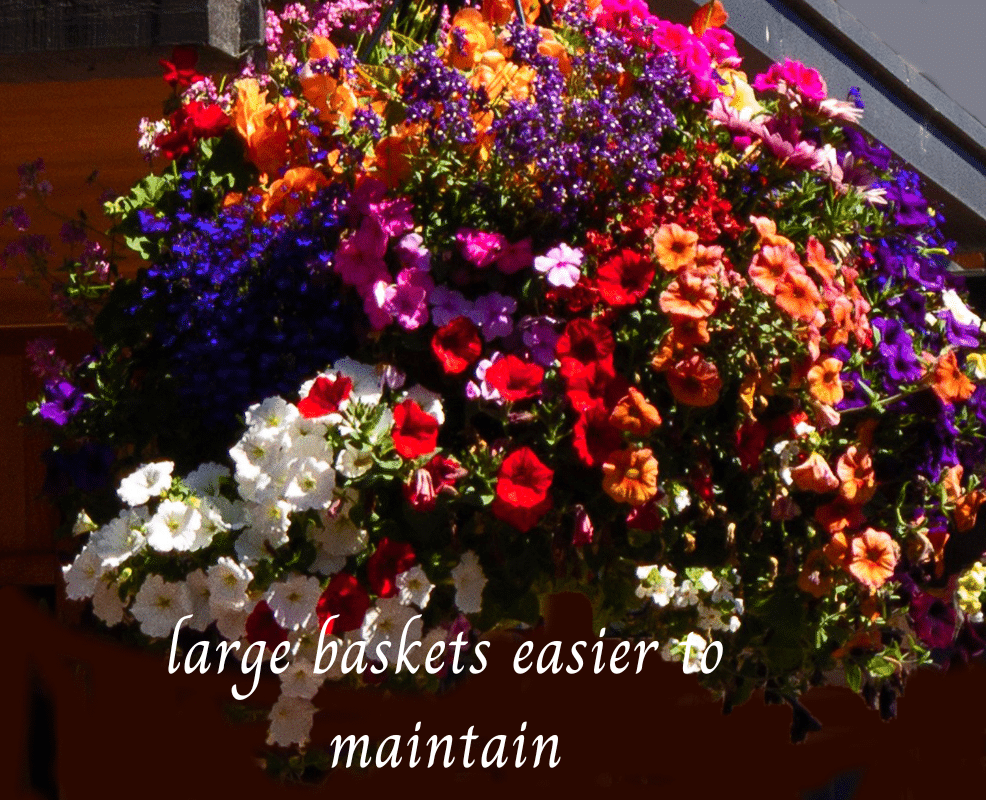
Size: Hanging baskets are like Texas – bigger is better! The small sizes dry out quickly, and in a dry, windy summer, this is an issue; you could be watering two or more times in a day.
At our house, we would consider 12”-14” in diameter to be the minimum size range to start with. Choose based on what appearance you are looking for and what your hanger (and you) can hold up. In the smaller sizes, deeper pots are offered, and the extra depth can be helpful in maintaining nutrition and moisture.
Moisture Essential for Baskets That Last All Season
Maintaining moisture is important enough that we are constantly working on it. Sometimes a layer of plastic (with drainage holes) in the lower half of the pot can help; some folks like to use a small clean sponge. A high-quality potting soil will include inert materials to hold water.
The manufacturers of the pots themselves have some inventive solutions:
For the Coir lined baskets, there is a product. Aqua Sav, which includes a recycled plastic insert sandwiched between two layers of coir. Reviews I have read say that in spring and fall, they can go seven days between watering with this product and in summer 2-3 days, rather than daily.
Within the plastic category, there are ‘Self Watering’ planters. These combine a capillary mat with an evaporation grill and a reservoir. You fill the reservoir from the lower level of the pot, making it easier with a high-hanging pot. If your desired placement requires a small pot, this can be even more helpful. An 18” pot of this type holds 1.5 quarts of water.
2. The Right Plants-For Long Lasting Baskets
In the limited space that hanging baskets give us to work with, the “Right Plant, Right Place” rule has enhanced importance. Season, zone, sun, and shade are important. A lot of the plants we are considering will be annuals, but sometimes a perennial can go into the ground beds at the end of the basket’s season.
We garden in Florida; our winter annuals are often the same ones our northern neighbors use in summer. In summer, our pots have more tropical and native varieties.
This table will highlight proven plant choices and categories in which they can be used. These are samples, for brevity’s sake. Check with your local garden center. Read the Labels – the information you need will be on each plant’s tag.
There are three plant habits that you will want in your baskets. A central plant for height. Some more plants to fill and spread to the sides of the planter, and third plants which will trail and cascade. This way, no matter where you are looking from, there is something good to see.
Sample Plants for Your Summer Hanging Baskets
| Full Sun | Part Sun | Full Shade | |
| Central Plants for Height | Geranium, Angelonia Zinnia | Begonia, Impatience | Fern, Coleus, Cyclamen |
| Caladium | Hosta | ||
| Spreading, Filling Plants | Petunia Dianthus | Lobelia, Torenia | Heuchera (Coral Bell) |
| Pansy Alyssum | Oxalis | Hosta | |
| Moss Rose | |||
| Trailing, Cascading | Ipomea, Scaveola, Nasturtium Dianthus Mandevilla | Black Eyed Susan Vine Creeping Jenny, Verbena | English Ivy, Algerian Ivy, Scandent Begonia Periwinkle, Fuchsia |
What About Planting Vegetable Hanging Baskets?
If sunny spaces to plant vegetables are in short supply, this might be a very helpful idea. Think of a basket filled with some of these delicious and beautiful ideas. Hang the baskets at easy-to-reach heights; combine tall vegetables with those that trail.
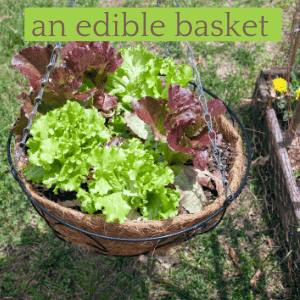
In edible baskets, plant for style and dinner. These mixed lettuce are handsome. Harvest leaf lettuce from the outside, and they will last the longest. When they are done, you can add other vegetables or some of the marigolds you see in the photos.
- Multicolored leaf lettuce.
- Strawberries.
- Small peppers.
- Any of the low-growing herbs.
- Include any flowers that require the same conditions. Try geraniums, marigolds, and bacopa, which will trail gracefully from the pots.
Use Your Hanging Baskets For Pollinator Plants
Many smaller annuals and even perennials will work in hanging baskets that will attract pollinators like butterflies and hummingbirds. Use this article on container butterfly gardens for some help. Use several baskets or larger baskets to keep nectar flowers blooming all season.
Add a mix of pollinator attractors.
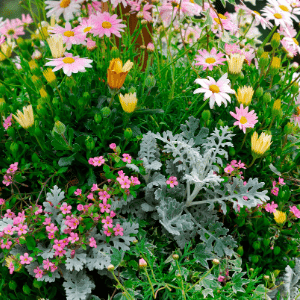
3. Best Method for Planting
Soil: High-quality potting soil is needed. It should feel light and soft in the bag. The soil mix should contain 20%-40% volcanic rock products. All the planting instructions I read specify both new and high-quality soil. If you recycle soil, ensure that your source did not contain a diseased plant and has no wildlife in it. You can improve reused soil by thoroughly mixing and addition of fresh potting soil. New soil is sterile in the bag; maintain it in as clean conditions as possible.
How much soil? Leave a good inch between the top of the soil and the top of the pot. This will prevent splashing during watering. How much to buy? As a reference, a 13″ pot will take about 8 quarts of soil.
Mix a slow-release fertilizer into the soil. For quantity, follow the instructions on the container. It should last about six weeks before you need to add more.
Hanging baskets are often rounded on the bottom, and the chains can be hard to remove. Try putting the planter in a pot or pail, and it will be easy to drape the chain along the outside of the pot. Arrange the plants in a convenient spot, dampen the soil, test them in the pot first, and add most of the soil. Start with the center plant – the tallest and star of the show. Add the major trailers, then fill in. Putting the trailers on a little angle gets them started doing their jobs.
How many plants? We fill tightly; we don’t want to wait too long for gratification, and the plants are not permanent residents. How many to use? It depends on the size and the picture you are trying to make. Here is a rule of thumb:
12-14” diameter basket-3-5 plants
16”-18” diameter basket-5-7 plants
18” diameter basket- at least 7, including six trailing plants.
Water the planted pot well, letting water flow out freely. Acclimate your newly planted pots out of the direct sun for 4-7 days if their destination is in the sun.
What kind of plants? The plants should include a centerpiece, plants to fill and spread along the surface, and some which will cascade down. The way in which you hang the planter will influence how you plant it.
Will you look up at the planter or straight at it, or down from an upper story? Our four new planters are at eye level from our dining table. The whole picture is important.
4. Best Maintenance for Long Lasting Baskets
You should be able to expect months of pleasure from this arrangement.
Water: do this as soon as the pot begins to dry. Use your finger to test, don’t rely on a schedule. In a hot summer, particularly with wind, you will expect to water daily unless you have a supplemental watering plan or a drip system in place. These plants are living in close quarters; avoid placing desert plants with water lovers.
If it is not inconvenient, try taking the planters down for a periodic, preferably weekly, deep soaking.
Do not allow the planter to dry out completely. When this happens, you will notice that the soil has pulled away from the sides of the pot, and the roots will be damaged. Should this happen, you can mitigate the problem with three thorough watering, 30 minutes apart. During the last one, water will finally get to the roots.
Overwatering is not usually a problem. If it is a concern, test this way. Put your finger in the soil, take up a small piece of soil, and try to make a ball of it. If it won’t form, a ball and water run out. It’s too wet. Let it dry.
Nutrition: These plants are now in production mode; they need to grow and produce blooms in profusion. Replace the time-release fertilizer in about six weeks (following the directions on the package). Add your favorite blooming fertilizer on a weekly basis.
Weeds should not be a problem; there is little space for them. You will want to deadhead and trim back any plant material which stretches too far. This will lengthen your months of enjoyment.
Some Cool Season Ideas
When fall and winter come, in our climate, we plant our cool season baskets, which to any northerner would be summer flowers. Here is an article with photos of pretty basket ideas for fall.
